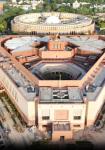Three human skeletons were recovered on Friday during excavations at the disputed site in Ayodhya in Uttar Pradesh.
An official associated with the exercise told this scribe over telephone: "Only the main bones of the skeletons looked intact, but we have not brought these out of the trenches."
The skeletons were found at a depth of two to three feet in the newly dug trenches behind the makeshift temple that stands on the debris of the 16th century Babri mosque.
The mosque was pulled down by radical Hindus in December 1992 triggering nationwide communal riots claiming hundreds of lives.
Undertaken from March 12 in pursuance of orders of the Allahabad high court, which is hearing a title suit, the excavations are aimed at establishing whether a Hindu temple existed at the site before Mughal emperor Babur built the mosque.
The court had given a month's time to the Archaeological Survey of India to complete the task. However, the deadline was extended twice and the ASI is now expected to be ready with its findings by June 15.
As many as 24 trenches have been dug around the temple and a large number of artefacts recovered so far have been documented and preserved by the ASI under the supervision of a court observer.
About a fortnight back, the ASI team had found the first skeleton. However, following objections raised by the Muslim representatives overseeing the work, it was neither extricated nor was the sport probed further.
Zafaryab Jilani, the legal counsel for Sunni Central Waqf Board, said: "The discovery of skeletons is a clear indication of the existence of a Muslim graveyard, which is what we have been claiming for years."





